The Marais
The South
Marais (Saint-Paul) is taken up in the Fourth Arrondissement
History of
the Marais
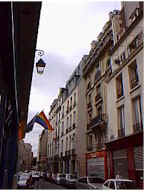 The Marais - which means marsh in French - is the area of modern day
Paris which was once covered by swamps. In the Twelfth Century the Templars cleared the
marshes located to the North of the Philippe Auguste wall. Beginning in the Sixteenth Century, but mostly after the creation of the
Royal Square by Henri IV in 1605 (later called the Place des Vosges), the Marais became
the preferred spot for the aristocratic mansions (hôtels
particuliers) built between the Sixteenth and
Eighteenth Centuries. When the King moved from the Royal Square to the Louvre then to
Versailles, the Marais began to decline. The high society came to prefer the districts
(faubourgs) of St. Honoré and St. Germain. In the Nineteenth Century, the Marais became
more and more populated with industries and production, some specializing in jewelry.
Under Haussmann, city planning regulations
were enforced and new buildings had to be set back from the street ("alignement") in order to progressively make
the old streets larger and wider. Many older buildings had not been destroyed however,
thus the streets are still quite irregular. The Marais - which means marsh in French - is the area of modern day
Paris which was once covered by swamps. In the Twelfth Century the Templars cleared the
marshes located to the North of the Philippe Auguste wall. Beginning in the Sixteenth Century, but mostly after the creation of the
Royal Square by Henri IV in 1605 (later called the Place des Vosges), the Marais became
the preferred spot for the aristocratic mansions (hôtels
particuliers) built between the Sixteenth and
Eighteenth Centuries. When the King moved from the Royal Square to the Louvre then to
Versailles, the Marais began to decline. The high society came to prefer the districts
(faubourgs) of St. Honoré and St. Germain. In the Nineteenth Century, the Marais became
more and more populated with industries and production, some specializing in jewelry.
Under Haussmann, city planning regulations
were enforced and new buildings had to be set back from the street ("alignement") in order to progressively make
the old streets larger and wider. Many older buildings had not been destroyed however,
thus the streets are still quite irregular.
At the turn of this century,
the Jewish community moved in around la rue Rosiers. Many arrivals from Central Europe
settled here, they became part of the quarter's fabric of small artisans and
industrialists. But the buildings of the Marais were hardly maintained, even the beautiful
houses were disfigured by the warehouses and workshops which had taken over.
In 1969, André Malraux, Minister of Culture, made the Marais a ‘protected
sector’(secteur sauvegardé) by applying the Law of Protection of the Country’s Heritage
("patrimoine"). This brought about another social mutation in the quarter. The small workshops
had all but disappeared, and now the middle class, the performance artists and the gay
community, who brought the multicolored flags that have multiplied around rue Sainte Croix
and rue de la Bretonnerie, moved into the Marais. Today the mansions of the Marais have
been rediscovered, but the artistic life that once animated the area has been lost - and
many deplore the quarter's new "museification." On Sundays the fashion boutiques
and home decor shops bring a large crowd to the area. This is especially true of Rue
Francs-Bourgeois, which has been named a Tourist Zone in order to obtain the authorization
to stay open on Sundays. Some of these stores have kept the signs from the former
occupants, thus there is a bakery ("boulangerie")
which sells shoes!
[Tour leaving from Metro
Rambuteau...]
Rue Rambuteau takes
its name from the Prefect of the Seine who preceded Haussmann, between1833 et 1848: He
built this road so it would cut through the old quarter- it was once the largest road in
the district.
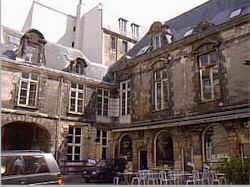 1- Rue du
Temple. # 71-75,
The Avaux de St-Aignan building, is decorated with Indian heads. 1- Rue du
Temple. # 71-75,
The Avaux de St-Aignan building, is decorated with Indian heads.
Café de la Gare, 41 rue du Temple
Currently under restoration, the old Berlize Hotel is now home to the famous Train Station
cafe-theater which has seen the debut of Splendid, a Tex-Mex restaurant and the School of Dance of the Marais. In the evenings around 6:00
p.m. the patchwork of music, dance steps and rhythms create an enchanting atmosphere in
the courtyard.
2- Rue Sainte-Croix de la Bretonnerie, this is a wonderful street filled
with boutiques and cafes. Farther along, at #23 rue du Roi de Sicile, is le PACTE. This
organization provides advice on fixing and renovating apartments through l'OPAH of the Marais, which has been serving the public for 3 years.
Tea shop Mariage Frères
3- Rue des Blancs-Manteaux, The animation space of Blancs-Manteaux, at the head of the street, hosts
expositions.
Rue vieille du Temple, #47, #54
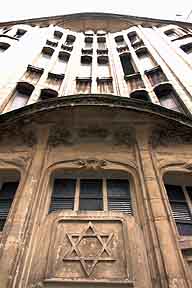 4- Rue des Rosiers, center of the Jewish quarter in the Marais, has become the traditional
Falafel stop; try l'As du Falafel or Jo Goldenberg at #15. 4- Rue des Rosiers, center of the Jewish quarter in the Marais, has become the traditional
Falafel stop; try l'As du Falafel or Jo Goldenberg at #15.
5- Rue Pavée
Synagogue, 10 rue Pavée
(Hector Guimard, Architect, 1913)
The synagogue was built in the
art nouveau style by architect Guimard in 1913, at the time when the Jewish Ashkenazi
refugees from Central Europe were settling in the district. C'est un exemple parfait de transition entre le modern-style et le style des
années 20 : l'harmonie y est totale entre la rigueur d'une construction en béton armé,
le dépouillement de l'ornementation, l'élégance des courbes et des contre-courbes de la
façade.
Bibliothèque historique de la ville
de Paris, Historical Library of the City of Paris, 24 rue Pavée, 4st
(metro Saint-Paul) (tel. 01 44 59 29 40, from 9 :30 -6 :00p.m. daily, except Sundays
and holidays)
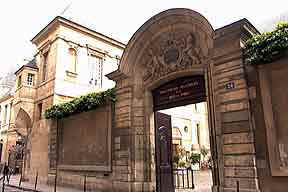 This mansion was built in 1584 for Diane of
France, the Duchess of Angouleme, legitimate daughter of Henry II. She left the letter
‘D’ on the main facade that looks onto the courtyard. The decor of arches,
arrows, quivers and dog heads shows Diane's taste for hunting. The eastern facade is a
rare composition : the Corinthian pilasters (with leaves) reach all the three floors. The
mansion was rented, then bought in 1688 by Chrestien Francois of Lamoingnon of Malesherbes
who enhanced the gardens that can be seen from Francs-Bourgeois Street. In 1718, he had a
gateway built carrying the letters ‘LM’. The two lovers represent the virtues of
the owner: one is holding a mirror, symbol of truth and the other a snake for prudence.
Today, the Lamoignon mansion houses the historical library of
the city of Paris. The contemporary extension built in 1966 hosts exhibitions. This mansion was built in 1584 for Diane of
France, the Duchess of Angouleme, legitimate daughter of Henry II. She left the letter
‘D’ on the main facade that looks onto the courtyard. The decor of arches,
arrows, quivers and dog heads shows Diane's taste for hunting. The eastern facade is a
rare composition : the Corinthian pilasters (with leaves) reach all the three floors. The
mansion was rented, then bought in 1688 by Chrestien Francois of Lamoingnon of Malesherbes
who enhanced the gardens that can be seen from Francs-Bourgeois Street. In 1718, he had a
gateway built carrying the letters ‘LM’. The two lovers represent the virtues of
the owner: one is holding a mirror, symbol of truth and the other a snake for prudence.
Today, the Lamoignon mansion houses the historical library of
the city of Paris. The contemporary extension built in 1966 hosts exhibitions.
6- Rue des Francs-Bourgeois, the hotels particuliers (grand houses) at #31 bis to 29 (the chapel at the
end of the garden is an ancient tower from Philippe Auguste's Enceinte, as the rue des
Francs-Bourgeois replaced the old exterior road), #30, #26
Hôtel Carnavalet, Carnavalet Mansion, #23-29, rue de Sévigné, 4st (visits
www,
then Agenda or Activités)
(métro Chemin-Vert, Saint-Paul) (tel. 01 42 72
21 13, from 10 a.m. to 5:40 p.m. daily, except Mondays
and holidays)
The
mansion is a beautiful example of Renaissance architecture. It was built in 1560 for the
president of the Paris Parliament, then it was acquired by the widow of a gentleman from
Brittany named ‘Carnavalet’. In the Seventeenth Century, it was sold to a
financier, who hired François Mansart to oversee the enlargement of the
mansion. It was then rented to Madame de Sevigné. From 1677 to 1694, the illustrious
epistolary had the parlor painted because her guests included La Rouchefoucault and Madame
de La Fayette among others, who were considered the cultivated minds and spirits of Paris.
From Francs-Bourgeois Street, you can see the rustic gateway typical of the Renaissance
era. It is carefully integrated into the posterior architecture by Mansart. The bas
reliefs represent Strength and Vigilance. The city of Paris bought the house in 1866 to
hold the decor of the buildings destroyed by Haussmann.
7- Place des Vosges, Vosges Square
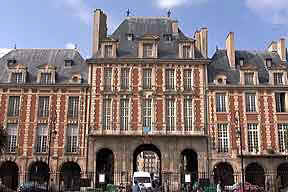 Constructed in 1612 by Henry IV
following a project of Catherine of Medicis, it was the first square in Paris to be
constructed in a coherent and orderly structure. Thereafter, it became the model for other
classic, geometric ‘royal squares’ with a mounted royal statue in its center. Constructed in 1612 by Henry IV
following a project of Catherine of Medicis, it was the first square in Paris to be
constructed in a coherent and orderly structure. Thereafter, it became the model for other
classic, geometric ‘royal squares’ with a mounted royal statue in its center.
Before the Place des Vosges was constructed, the royal residences were located on the
northern side of the present square. Built in 1388 and purchased by the Crown in 1407, the
Tournelle mansion was a big and beautiful property surrounded by walls and small towers
from which it got its name. During a tournament in 1559 in St. Antoine Street, the king,
Henry II, received a blow from the lance of the captain of his Guards. After 10 days of
agony, he passed away in the Tournelles mansion. After this tragic event, his wife,
Catherine of Medicis had the mansion torn down and moved into the Louvre. A large horse
market took the place of the former mansion. The first ‘urbanist’ king to put
his city projects to work was Henri IV. He had the King's pavilion built in 1604 to the
south, followed by 35 other pavilions which were designed along the same model. ‘The
King’s’ and ‘the Queen’s’ pavilions, as they were called, were
constructed facing each other but were never occupied by the monarchy. The square was
completed in April 1612 to celebrate the marriage of Louis XIII to Anne of Austria (and
that of the king’s sister to Philippe IV of Spain). The royal square which was not
yet a garden, became the center of the elegant life, a place of trade, walks and leisure,
and a meeting place for duels by those who braved Richelieu’s ban. With the departure
of Louis XIV for Versailles, the aristocracy left the Marais to build their mansions in
the St. Germain quarter but the noblesse de robe remained faithful to the square.
Place des Vosges is in the shape of a square surrounded by 36
pavilions made of brick (or stones covered with a coating resembling brick) all built on
top of arcades. The high second floor is the luxurious one. The arcades, the stone window
casings and the slanted slate roofs avoid monotony. Stores open onto the vaulted galleries
: antique shops, book stores and other boutiques liven up the square even today. Behind
the Place are courtyards with hidden gardens. In the center of the square, Richelieu had a
statue of Louis XIII mounted on horseback built in 1639. It was melted during the
Revolution and replaced in 1825 by another statue in white marble. In the Nineteenth
Century, a garden was installed in the Place, which the city of Paris restored in 1988.
After changing names many times, the square was named ‘Place des Vosges’ (Vosges
Square) in 1800 by Napoleon to thank this department for having paid its taxes first. It
returned to being the Royal Square from 1815-1870.
Musée Victor-Hugo, Victor Hugo Museum, 6 place des Vosges, 4st
(métro Saint-Paul, Bastille) (tél. 01 42 72 10 16, from 10a.m.-5:40p.m. daily, except Mondays and holidays)
Victor Hugo lived here from 1832-1848. He led his somewhat mundane family,
literary and political life on the third floor of the Rohan-Guemenee mansion. Given to the
city of Paris in 1902, the drawings, paintings, books, objects and souvenirs are set up in
chronological order. His childhood, his youth, his marriage to Adele Foucher, his exile
from 1852-1870. The furniture at Vosges Square was auctioned off and redistributed, thus
the museum is not a true reconstruction of the poet’s apartment. The museum displays
furniture and engraved panels created by Victor Hugo while in exile. They show how his
taste for decoration ran wild. When he returned from exile in 1870, he moved in with
Juilette Drouet on Eulau Avenue (now called Victor Hugo Avenue, Sixteenth Arrondissement).
On the first floor, the poet’s drawings are displayed. You can see the occasional
cruel caricature, ‘oceanic’ and medieval architectural drawings of which he said
to fellow writer Baudelaire, ‘I have finished mixing the pen with pencil, charcoal,
sepia, coal, soot and all sorts of bizarre mixtures which have helped to express what I
see with my eyes and my mind. I find it amusing in between two stanzas.’
[Return by the rue de
Bearn...][Or continue on towards Saint-Paul and l'Hôtel de Ville, take the covered passage towards the gardens of the Hotel de Sully
.... ]
8- Rue du Parc Royal : mansions (hotels particuliers) and a pleasant square L. Achille
Rue Payenne
bordered by a second square, G. Cain
9- Cognacq-Jay museum, 8 rue Elzévir
(métro Saint-Paul) (tel. 01 40 27 07 21, from 10a.m. to 5:40p.m. daily except Mondays
and holidays)
Dedicated to furniture
and art from the Eighteenth Century, the museum was set up in 1988 in the Donon mansion.
Built in 1575 for Mederic de Donon, building controller for the King, its street facade
dates back to the Eighteenth Century. Founders of the Samaritaine, Ernest Cognacq and Louise Jay built an interesting
collection that was willed to the city of Paris in 1929. Paintings, furniture and other
objects evoke the refined atmosphere of the Eighteenth Century.
Musée de la serrurerie, Museum of Locksmiths or Bricard
Museum, place de Thorigny, 1 rue de la Perle
(métro Saint-Paul) (tel. 01 42 77 79 62, from 2-5 p.m. daily
except Saturdays, Sundays, holidays and the month of August)
(Libéral Bruant, Architect, 1685)
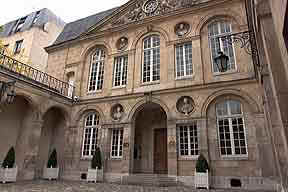 The
museum is set up in an old mansion that was nicely restored. The mansion was erected in
1685 like the neighboring buildings, where Liberal Bruant lived. The building is a very
different style than Les Invalides, which the architect had constructed a few years
earlier. Covering the whole facade is the pierced oculus fronton, decorated with
cornucopias and two amorettos. One of the stairwells is decorated with illusion paintings.
The mansion was bought and restored by the Bricard company which specializes in decorative
locks and iron works. The museum exhibits bronze keys, Gallo-Roman iron keys, gothic door
knockers from the Middle Ages, keys and locks from the Sixteenth through Nineteenth
Centuries. A locksmith’s workshop has also been reconstructed. The
museum is set up in an old mansion that was nicely restored. The mansion was erected in
1685 like the neighboring buildings, where Liberal Bruant lived. The building is a very
different style than Les Invalides, which the architect had constructed a few years
earlier. Covering the whole facade is the pierced oculus fronton, decorated with
cornucopias and two amorettos. One of the stairwells is decorated with illusion paintings.
The mansion was bought and restored by the Bricard company which specializes in decorative
locks and iron works. The museum exhibits bronze keys, Gallo-Roman iron keys, gothic door
knockers from the Middle Ages, keys and locks from the Sixteenth through Nineteenth
Centuries. A locksmith’s workshop has also been reconstructed.
10- Musée Picasso, 5 rue Thorigny (www musexpo)
(métro Saint-Sébastien Froissart, Saint-Paul) (tel 01 42 71 25 21, Every day except Tuesday 9:30 a.m. to 6:00 p.m., Closes at 5:30 p.m. in
winter, Open Wednesday nights until 10:00 p.m.)
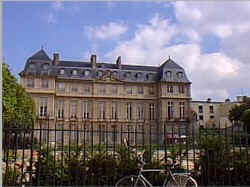 The Picasso Museum is housed
in the Salé Mansion, constructed in 1656. The lovely mansion was built for Aubert de
Fontenay, a salt tax collector, which explains the name Parisians gave to the mansion:
salé in French means salted. The museum was established in 1985 thanks to a new law
regarding the surrender of property in lieu of the payment of inheritance taxes. The State
inherited 203 paintings, 158 sculptures and more than 3,000 drawings as a result. A second
inheritance enriched the museum in 1990; Jacqueline Picasso's gave around one hundred
works of contemporary artists which had belonged to Picasso. The furniture in the museum
was designed by Diego Giacometti, the brother of the sculptor Alberto. Diego designed the
benches, the bronze tables and chairs, and the chandeliers made of white resin. Organized
in a chronological manner, the museum is in some ways a continuation of the museum in
Barcelona: it begins with the blue and rose period, followed by the cubist paintings, but,
above all, it exhibits the works completed before the 1920's. The Picasso Museum is housed
in the Salé Mansion, constructed in 1656. The lovely mansion was built for Aubert de
Fontenay, a salt tax collector, which explains the name Parisians gave to the mansion:
salé in French means salted. The museum was established in 1985 thanks to a new law
regarding the surrender of property in lieu of the payment of inheritance taxes. The State
inherited 203 paintings, 158 sculptures and more than 3,000 drawings as a result. A second
inheritance enriched the museum in 1990; Jacqueline Picasso's gave around one hundred
works of contemporary artists which had belonged to Picasso. The furniture in the museum
was designed by Diego Giacometti, the brother of the sculptor Alberto. Diego designed the
benches, the bronze tables and chairs, and the chandeliers made of white resin. Organized
in a chronological manner, the museum is in some ways a continuation of the museum in
Barcelona: it begins with the blue and rose period, followed by the cubist paintings, but,
above all, it exhibits the works completed before the 1920's.
A section of the Salé Mansion garden is
opened to the public, accessible from rue des Coutures.
11- CARAN:
The National
Archives Reception Desk and Research Center,
11 rue des Quatre-Fils
(métro Rambuteau)
(Stanislas Fiszer, Architect,1988)
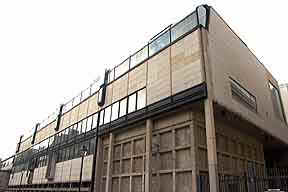 The completely
modern building was constructed by Stanislas Fiszer in 1988 and designed to blend into the
historical heart of Paris with the help of its spacing and materials. The facade assures
the transition between the small, classic style houses on the left (they are low and split
up) and the Nineteenth Century archives depot on the right side, (the facade stands tall
and stretches a long ways). In the middle, ‘the building disappears in front of the
Rohan house and takes on these same proportions’. The cornices are the same height;
the facade is divided into the same 16 identical squares, ‘neutral and symmetrical
surfaces’. Less obvious than the central entrance, the lateral entrance provides a
view of the garden. As for the materials, the architect used the traditional Parisian
stone- but plated- and added some glass and black metal. The completely
modern building was constructed by Stanislas Fiszer in 1988 and designed to blend into the
historical heart of Paris with the help of its spacing and materials. The facade assures
the transition between the small, classic style houses on the left (they are low and split
up) and the Nineteenth Century archives depot on the right side, (the facade stands tall
and stretches a long ways). In the middle, ‘the building disappears in front of the
Rohan house and takes on these same proportions’. The cornices are the same height;
the facade is divided into the same 16 identical squares, ‘neutral and symmetrical
surfaces’. Less obvious than the central entrance, the lateral entrance provides a
view of the garden. As for the materials, the architect used the traditional Parisian
stone- but plated- and added some glass and black metal.
Although this quarter was affected by Paris' increasing density in
the Eighteenth and Nineteenth Centuries, some of the old mansions (hotels particuliers)
have survived [rue de Braque, rue Pastourelle, rue de Beauce...]
Rue des Archives (Archives
Street)
12- Musée de la chasse et de la nature, Museum
of Hunting and Nature, 60 rue des Archives
(metro Rambuteau) (tel. 01 42 72 86 43, from 10a.m. to 12:30 and
1:30 to 5:30p.m. daily except Tuesdays and holidays)
(François
Mansart, Architect, 1655)
The
museum occupies the Guenugaud des Brosses mansion which was originally built in 1655 by
Mansart for the King's Savings Treasury. Its history is otherwise typical of the mansions
of the Marais. In the Nineteenth Century, the house was divided into art studios. Brought
to a state of complete dilapidation, it was rescued by the intervention of André Malraux,
the Minister of Culture, when it was placed in the Marais' protected zone. The City of
Paris bought the mansion in 1961, and classified it as a historical monument. It was
rented to Francois and Jacqueline Sommer who had it restored for the House of Hunting and
Nature, which opened in 1967. Today, it has a private club as well as a museum. The museum
evokes hunting through hunting weapons (prehistoric weapons, crossbows and arquebuses from
the Sixteenth and Seventeenth Centuries, fire arms from the Sixteenth through Nineteenth
Centuries), paintings by Rembrandt, Breughel, Desportes, Monet and naturalized animal
trophies, such as bears and caribou. The protection of nature is also a theme around which
exhibitions are organized.
Along rue Quatre-Fils, the French style garden was recreated when the house was restored.
At 58, rue des Archives, a fortified door dressed with two
(overhanging) corbel turrets reveal the
vestiges of a house dating from 1375. These are the only private architectural traces of
that era in Paris. Today, these are included in the National Archives.
(Incursion
vers la rue du Temple...)
Musée
d'art et d'histoire du judaïsme, 71 rue du Temple
(métro Rambuteau) (tel. 01 53 01 86 53, ouvert 11.00-18.00 sauf samedi, 10.00-18.00
le dimanche)
L'hôtel Saint-Aignan (17è s) vient d'être
restauré pour y accueillir ce nouveau musée chargé de conserver, étudier et diffuser
le patrimoine culturel du judaïsme. Il est notamment constitué de la collection du
musée d'art juif et de la collection Strauss-Rothschild qui relatent l'évolution des
communautés juives du Moyen-Age au 20è siècle à travers leurs arts, leur patrimoine et
leurs traditions.
13- Les Archives nationales, National Archives, 60 rue des Francs-Bourgeois
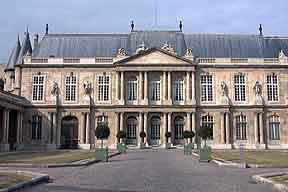 In
1705 the Prince of Soubise had a somber, classic and imposing palace rebuilt by Delamair.
It contrasts with the interior rocaille decor, which was designed by Bouffrand. The
national archives were created during the Revolution (1790) to keep track of the documents
of the newly created National Assembly. Napoleon put the archives in the Soubise Palace in
1808, but they were later moved to the Rohan House and four other neighboring houses. The
extension of the archives, with their 450 km of isles, brought about the CARAN structure.
The Archives hold the original documents from institutions dating from the Merovingian
kings up to contemporary times. Today, the Palace de Soubise houses the museum of the
History of France. In
1705 the Prince of Soubise had a somber, classic and imposing palace rebuilt by Delamair.
It contrasts with the interior rocaille decor, which was designed by Bouffrand. The
national archives were created during the Revolution (1790) to keep track of the documents
of the newly created National Assembly. Napoleon put the archives in the Soubise Palace in
1808, but they were later moved to the Rohan House and four other neighboring houses. The
extension of the archives, with their 450 km of isles, brought about the CARAN structure.
The Archives hold the original documents from institutions dating from the Merovingian
kings up to contemporary times. Today, the Palace de Soubise houses the museum of the
History of France.
Musée de l'histoire de France, Museum of the
History of France, 60 rue des
Francs-Bourgeois
(métro Rambuteau) (tel. 01 40 27 62 18, from noon
to 5:45p.m. daily except Tuesdays and holidays; from 1:45p.m. - 5:45p.m. Saturdays and
Sundays)
Set
up in the beautiful Soubise mansion that once housed the National Archives, the museum
makes available the important historical documents of France. The exuberant baroque decor
by Boffrand (dating from 1740) has been preserved in the apartments on the ground floor.
When the architect Delamair built the new Soubise mansion in 1708, he integrated the
Clisson (around 1375) and Guise (Sixteenth Century) mansions into it. Thus, the chapel on
the second floor is in fact that from the Clisson mansion. The old guard rooms from the
Guise house display the important historical documents of France dating from the
Merovingian kings to the Second World War, such as the memoirs of Colbert, the wills of
Louis XIV and Napoleon, and a letter from Voltaire on the Calas case. Among the important
historical acts shown in the museum are the Edict of Nantes, the Westphalia Treaty
(whereby France repurchased Alsace in 1648), and the Declaration of the Rights of Man.
Other texts give testimony to economic and social history: tolls for crossing the Seine,
the Nineteenth Century law on child labor and the 1936 law on paid vacations.
The courtship room of the princess of
Soubise and the oval room have been recently restored. The magnificent rocaille decoration
was done by Boffrand in 1735 ; the paintings are mostly the works of Boucher and
Tremolieres. The bedroom of the Princess which is dedicated to the French Revolution
displays many documents : the ‘serment de jeu de paume’ (the oath of the
Assembly to vote for a constitution), the last letters of Marie-Antoinette and Charlotte
Corday. Also on display are newspapers, signs, caricatures, songs and long texts dealing
with administrative organization such as the creation of the departments, and the metric
system...
The Culture Minister's website provides further
information on the archives.
The gardens are
attached to those of the Hotel de Rohan.
Hôtel de
Rohan, Rohan House,
87 rue Vieille-du-Temple
(from noon to 6p.m. daily except Mondays and holidays)
The Rohan house was built for one of the sons of the Prince of Soubise. Richly
endowed with a monumental, classic facade with colonnades and pilasters, it is now the Central
Register of the Notary Minutes of Paris. The old stables located to the right of the
courtyard are decorated with a bas relief by Robert Le Lorrain, ‘the sun horses.' The
inside of the house is well conserved, especially the stairwell and the monkey cabinets.
This wood interior from 1750 is evidence of the eroticism and voyages that were the
fashion of the day. The mansion often hosts traveling exhibitions.
At # 40, rue des Archives, the former house of Jacques Coeur's daughter has become a
nursery school.
Cloître des Billettes, Cloisters
of Billettes, 22-26 rue des Archives, 4st
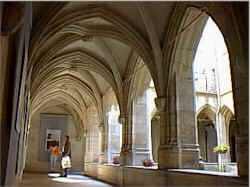 This is the only medieval
cloister existing in Paris. Dating from 1427 and decorated with flamboyant vaults, it
originates from a Thirteenth Century Monastery (the brothers of the Notre-Dame Charity
were called "Billettes," then "Carmites.") Housing collections of Art,
it is open to passerby's. Next door, the convent's church was reconstructed many times.
Dating from 1756, the present building was used by an evangelical cult in 1812. This is the only medieval
cloister existing in Paris. Dating from 1427 and decorated with flamboyant vaults, it
originates from a Thirteenth Century Monastery (the brothers of the Notre-Dame Charity
were called "Billettes," then "Carmites.") Housing collections of Art,
it is open to passerby's. Next door, the convent's church was reconstructed many times.
Dating from 1756, the present building was used by an evangelical cult in 1812.
Around Arts et Métiers
(Start from métro
Réaumur Sébastopol...)
Magasin Félix Potin, #51 rue Réaumur
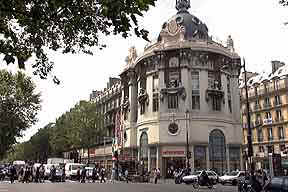 At the corner of Reaumur Street and the Sebastopol Boulevard, this opulent
store is proof of the prosperity at the turn of the century. It closed its doors in 1996
and is now a Monoprix store. Built in 1910, the large dome is quite typical of the
bourgeois buildings from this era. The big store is noticeable by its decorated facade of
profuse colors and bees which symbolize business and abundance. At the corner of Reaumur Street and the Sebastopol Boulevard, this opulent
store is proof of the prosperity at the turn of the century. It closed its doors in 1996
and is now a Monoprix store. Built in 1910, the large dome is quite typical of the
bourgeois buildings from this era. The big store is noticeable by its decorated facade of
profuse colors and bees which symbolize business and abundance.
Station de métro Arts et Métiers, The
Arts and Professions Metro Station
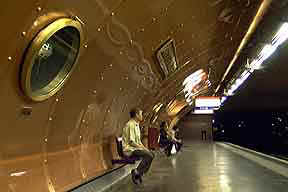 The
station on line 11 was completely redone by Francois Schuiten. This Belgian artist was
inspired by the technological universe from the National Center of Arts and Professions
(CNAM) and its museum. He drew a copper vault and a big mechanism for the ceiling. The
brass domes display models from the CNAM, such as the first airship... The
station on line 11 was completely redone by Francois Schuiten. This Belgian artist was
inspired by the technological universe from the National Center of Arts and Professions
(CNAM) and its museum. He drew a copper vault and a big mechanism for the ceiling. The
brass domes display models from the CNAM, such as the first airship...
14- Musée des Arts et Métiers, Museum of Arts and Professions,
access through 60 rue Réaumur, 292 rue Saint-Martin (www
of museum, www of
the CNAM)
(métro Arts et métiers) (tel. 01 40 27 23 31
ou 01 40 27 22 20)
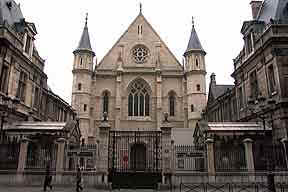 The
museum occupies the former Abbey of St. Martin des Champs, built in the Eighteenth
Century. The Abbey was transformed into a Conservatory of Arts and Professions in 1789,
after it was denied its religious function during the Revolution. The museum of Techniques
was open to the public in 1802 thanks to Jacques Vaucanson who had given automation
objects and the belongings of the emigrants confiscated during the Revolution to the King.
The museum is now being completely reorganized, and will reopen in 1999. 8,000 objects
illustrate the history of techniques and innovations from the Sixteenth Century through
today : automation, machines, tools, test rooms, discoveries in chemistry (the echo room),
energy, astronomy, meteorology and mathematics (calculating machines), telecommunications,
physics and optic labs In the old church of St. Martin des Champs you will find suspended
planes and a locomotive by Stephenson. The
museum occupies the former Abbey of St. Martin des Champs, built in the Eighteenth
Century. The Abbey was transformed into a Conservatory of Arts and Professions in 1789,
after it was denied its religious function during the Revolution. The museum of Techniques
was open to the public in 1802 thanks to Jacques Vaucanson who had given automation
objects and the belongings of the emigrants confiscated during the Revolution to the King.
The museum is now being completely reorganized, and will reopen in 1999. 8,000 objects
illustrate the history of techniques and innovations from the Sixteenth Century through
today : automation, machines, tools, test rooms, discoveries in chemistry (the echo room),
energy, astronomy, meteorology and mathematics (calculating machines), telecommunications,
physics and optic labs In the old church of St. Martin des Champs you will find suspended
planes and a locomotive by Stephenson.
Eglise Saint-Nicolas-des-Champs,
St-Nicolas-des-Champs Church,
254 rue Saint-Martin
(tél. 01 42 72 92 54, open from 9 a.m. to 7 p.m.
daily, except Sundays, 9 :30 to noon. July and August from 2 p.m. to
7 p.m.)
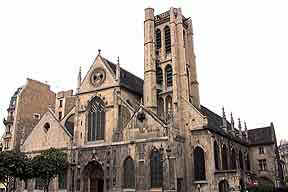 The
Church's history is typical of most in Paris. The first chapel was erected by a parish in
the Twelfth Century. From the gothic reconstruction in the Fifteenth Century the church
got its facade, bell tower and part of the church. In the Sixteenth Century, the nave and
the border of chapels were elongated and a southern door was built. The milieu of the
Eighteenth Century marked the return of antique shapes : the columns of the choir were
fluted and topped with wavy, ionic capitals and the stained glass windows were replace by
clear glass. The Revolution closed the church and turned it into a temple of marriage and
fidelity. It was given to a cult in 1802 and reestablished by the Restoration. The
construction of Turbigo Street in 1854 provides a view of the southern and eastern
facades. The
Church's history is typical of most in Paris. The first chapel was erected by a parish in
the Twelfth Century. From the gothic reconstruction in the Fifteenth Century the church
got its facade, bell tower and part of the church. In the Sixteenth Century, the nave and
the border of chapels were elongated and a southern door was built. The milieu of the
Eighteenth Century marked the return of antique shapes : the columns of the choir were
fluted and topped with wavy, ionic capitals and the stained glass windows were replace by
clear glass. The Revolution closed the church and turned it into a temple of marriage and
fidelity. It was given to a cult in 1802 and reestablished by the Restoration. The
construction of Turbigo Street in 1854 provides a view of the southern and eastern
facades.
15- Marché des Enfants-Rouges, Market of the Red Children, entre la rue
des Oiseaux et la rue de Bretagne
The oldest of the 13 covered
markets in Paris is located between the rue des Oiseaux and the rue de Bretagne. Named
after the pensioners of an old orphanage who dressed in red cloths, the market was the
object of a dispute in 1994-5. Some of the inhabitants were opposed to its demolition,
which would have made room for a parking garage, a market and a day care center. The new
socialist Mayor, Pierre Aidenbaum, promised to conserve the old market.
Carreau du Temple, surrounded by the streets Eugène-Spuller, Dupetit-Thouars, Picardie, Perrée, square du Temple
The Templar had a monastery built at the end of the Twelfth Century from the spoils of
the Crusades. The roads rue du Temple (Temple Street) and rue Vielle-du-Temple (Old Temple
Street) lead to the monastery. After the suppression of the Templars in 1311, the riches
of the Temple were transferred to the "Hospitaliers," notably the Parisian
monastery. The temple was enhanced by a thick walled tower, then a palace for the grand
prayer in 1567. The enclosed area was for those with the right of asylum; numerous
artisans (and money borrowers....) stayed there. Used as a prison for the Royal Family
during the Revolution, the tower was destroyed in 1811. The prayer room became a religious
house before its destruction in 1853, and was then transformed into a square in 1857. The
enclosure became a clothes market, set up in a rotunda in 1781.
Starting in 1809, four new wood pavilions sold lace, silks, cottons,
used clothes (in the Pavilion of Flying Lice) and old leathers. Small commerce also moved
in, which had been installed next to the
Market of the Innocents. Considered unhygenic, in 1863 the pavilions were replaced by iron and glass
structures, which still exist in part today. They were built by Merindol in the style of
Baltard. The Square met its end at the turn of the century, in part from the competition
of the new Saint-Ouen flea market. The four principal pavilions located along the rue du Temple were
destroyed. When the municipality wanted to condemn the two remaining pavilions in 1973,
the local inhabitants and business people mobilized and forced the city to rescind its
plan. The inferior section was once made of red and yellow bricks. The stone casings
around the lateral entrances are vestiges of the ancient rotonda.
Advertising cyber-café
Associations
of the 3rd Arrondissement
Mayor
Pierre Aidenbaum, 2 rue Eugène Spuller, 75 141 Paris cedex 3,
métro République, tel. 01 42 74 20 03
Statistical
Table of the 3rd
Statistiques du recensement de 1990
Sondage de l'INSEE au 1/4 |
Chiffres du 3è |
Chiffres de Paris |
Chiffres de l'agglomération
parisienne |
| Population totale |
35 043 |
2 151 245 |
9 316 656 |
Population par âge (en %)
0-19 ans
20-39 ans
40-59 ans
60-74 ans
+ de 75 ans |
17,5
39,3
24,2
11,1
7,8 |
18,6
35,9
24,7
12,2
8,5 |
25,5
33,8
24,7
10,2
5,7 |
Familles (couples et
enfants)
dont enfants
Personnes habitant seules (en % des ménages)
Nombre de personnes par ménage |
21 660
7 412
56,3
1,78 |
1 423 932
491 292
49,8
1,92 |
7 486 068
2 920 272
33,2
2,41 |
Taux d'activité (en %)
dont chomeurs |
63,9
10,3 |
60,9
9,7 |
62,5
9 |
Catégories socio-professionnelles des
ménages (selon personne de référence) (en %)
Agriculteurs exploitants
Artisans, commerçants, chefs d'entreprises
Cadres professions intellectuelles sup.
Professions intermédiaires
Employés
Ouvriers
Retraités
Autres (élèves, étudiants, "au foyer") |
0
7,6
26,5
13,4
11,5
10,4
20,3
10,2 |
0
5,5
23,4
13,9
13,8
10,5
23,4
9,4 |
0,1
5,3
18,4
16,3
14,2
17,4
22,3
6,0 |
Statut d'occupation du logement
par les ménages (en %)
Propriétaires-occupants
Locataires
Logés gratuitement
Logements sans confort
= (sans salle de bain ni WC intérieurs) |
31,3
57,3
11,4
11,4 |
28,3
63,0
8,7
8,1 |
40,2
54,0
5,8
3,9 |
Ménages ne disposant pas de voitures (en %)
Actifs travaillant à Paris
= (même commune pour l'agglomération) |
64,2
76,4 |
53,7
72,9 |
34,5
33,9 |
Internet sites of the 3rd Arrondissement |
 This mansion was built in 1584 for Diane of
France, the Duchess of Angouleme, legitimate daughter of Henry II. She left the letter
‘D’ on the main facade that looks onto the courtyard. The decor of arches,
arrows, quivers and dog heads shows Diane's taste for hunting. The eastern facade is a
rare composition : the Corinthian pilasters (with leaves) reach all the three floors. The
mansion was rented, then bought in 1688 by Chrestien Francois of Lamoingnon of Malesherbes
who enhanced the gardens that can be seen from Francs-Bourgeois Street. In 1718, he had a
gateway built carrying the letters ‘LM’. The two lovers represent the virtues of
the owner: one is holding a mirror, symbol of truth and the other a snake for prudence.
Today, the Lamoignon mansion houses the historical library of
the city of Paris. The contemporary extension built in 1966 hosts exhibitions.
This mansion was built in 1584 for Diane of
France, the Duchess of Angouleme, legitimate daughter of Henry II. She left the letter
‘D’ on the main facade that looks onto the courtyard. The decor of arches,
arrows, quivers and dog heads shows Diane's taste for hunting. The eastern facade is a
rare composition : the Corinthian pilasters (with leaves) reach all the three floors. The
mansion was rented, then bought in 1688 by Chrestien Francois of Lamoingnon of Malesherbes
who enhanced the gardens that can be seen from Francs-Bourgeois Street. In 1718, he had a
gateway built carrying the letters ‘LM’. The two lovers represent the virtues of
the owner: one is holding a mirror, symbol of truth and the other a snake for prudence.
Today, the Lamoignon mansion houses the historical library of
the city of Paris. The contemporary extension built in 1966 hosts exhibitions.
 Constructed in 1612 by Henry IV
following a project of Catherine of Medicis, it was the first square in Paris to be
constructed in a coherent and orderly structure. Thereafter, it became the model for other
classic, geometric ‘royal squares’ with a mounted royal statue in its center.
Constructed in 1612 by Henry IV
following a project of Catherine of Medicis, it was the first square in Paris to be
constructed in a coherent and orderly structure. Thereafter, it became the model for other
classic, geometric ‘royal squares’ with a mounted royal statue in its center. The
station on line 11 was completely redone by Francois Schuiten. This Belgian artist was
inspired by the technological universe from the National Center of Arts and Professions
(CNAM) and its museum. He drew a copper vault and a big mechanism for the ceiling. The
brass domes display models from the CNAM, such as the first airship...
The
station on line 11 was completely redone by Francois Schuiten. This Belgian artist was
inspired by the technological universe from the National Center of Arts and Professions
(CNAM) and its museum. He drew a copper vault and a big mechanism for the ceiling. The
brass domes display models from the CNAM, such as the first airship...
 The Marais - which means marsh in French - is the area of modern day
Paris which was once covered by swamps. In the Twelfth Century the Templars cleared the
marshes located to the North of the
The Marais - which means marsh in French - is the area of modern day
Paris which was once covered by swamps. In the Twelfth Century the Templars cleared the
marshes located to the North of the 
 4-
4-  The
museum is set up in an old mansion that was nicely restored. The mansion was erected in
1685 like the neighboring buildings, where Liberal Bruant lived. The building is a very
different style than Les Invalides, which the architect had constructed a few years
earlier. Covering the whole facade is the pierced oculus fronton, decorated with
cornucopias and two amorettos. One of the stairwells is decorated with illusion paintings.
The mansion was bought and restored by the Bricard company which specializes in decorative
locks and iron works. The museum exhibits bronze keys, Gallo-Roman iron keys, gothic door
knockers from the Middle Ages, keys and locks from the Sixteenth through Nineteenth
Centuries. A locksmith’s workshop has also been reconstructed.
The
museum is set up in an old mansion that was nicely restored. The mansion was erected in
1685 like the neighboring buildings, where Liberal Bruant lived. The building is a very
different style than Les Invalides, which the architect had constructed a few years
earlier. Covering the whole facade is the pierced oculus fronton, decorated with
cornucopias and two amorettos. One of the stairwells is decorated with illusion paintings.
The mansion was bought and restored by the Bricard company which specializes in decorative
locks and iron works. The museum exhibits bronze keys, Gallo-Roman iron keys, gothic door
knockers from the Middle Ages, keys and locks from the Sixteenth through Nineteenth
Centuries. A locksmith’s workshop has also been reconstructed. The Picasso Museum is housed
in the Salé Mansion, constructed in 1656. The lovely mansion was built for Aubert de
Fontenay, a salt tax collector, which explains the name Parisians gave to the mansion:
salé in French means salted. The museum was established in 1985 thanks to a new law
regarding the surrender of property in lieu of the payment of inheritance taxes. The State
inherited 203 paintings, 158 sculptures and more than 3,000 drawings as a result. A second
inheritance enriched the museum in 1990; Jacqueline Picasso's gave around one hundred
works of contemporary artists which had belonged to Picasso. The furniture in the museum
was designed by Diego Giacometti, the brother of the sculptor Alberto. Diego designed the
benches, the bronze tables and chairs, and the chandeliers made of white resin. Organized
in a chronological manner, the museum is in some ways a continuation of the museum in
Barcelona: it begins with the blue and rose period, followed by the cubist paintings, but,
above all, it exhibits the works completed before the 1920's.
The Picasso Museum is housed
in the Salé Mansion, constructed in 1656. The lovely mansion was built for Aubert de
Fontenay, a salt tax collector, which explains the name Parisians gave to the mansion:
salé in French means salted. The museum was established in 1985 thanks to a new law
regarding the surrender of property in lieu of the payment of inheritance taxes. The State
inherited 203 paintings, 158 sculptures and more than 3,000 drawings as a result. A second
inheritance enriched the museum in 1990; Jacqueline Picasso's gave around one hundred
works of contemporary artists which had belonged to Picasso. The furniture in the museum
was designed by Diego Giacometti, the brother of the sculptor Alberto. Diego designed the
benches, the bronze tables and chairs, and the chandeliers made of white resin. Organized
in a chronological manner, the museum is in some ways a continuation of the museum in
Barcelona: it begins with the blue and rose period, followed by the cubist paintings, but,
above all, it exhibits the works completed before the 1920's. The completely
modern building was constructed by Stanislas Fiszer in 1988 and designed to blend into the
historical heart of Paris with the help of its spacing and materials. The facade assures
the transition between the small, classic style houses on the left (they are low and split
up) and the Nineteenth Century archives depot on the right side, (the facade stands tall
and stretches a long ways). In the middle, ‘the building disappears in front of the
Rohan house and takes on these same proportions’. The cornices are the same height;
the facade is divided into the same 16 identical squares, ‘neutral and symmetrical
surfaces’. Less obvious than the central entrance, the lateral entrance provides a
view of the garden. As for the materials, the architect used the traditional Parisian
stone- but plated- and added some glass and black metal.
The completely
modern building was constructed by Stanislas Fiszer in 1988 and designed to blend into the
historical heart of Paris with the help of its spacing and materials. The facade assures
the transition between the small, classic style houses on the left (they are low and split
up) and the Nineteenth Century archives depot on the right side, (the facade stands tall
and stretches a long ways). In the middle, ‘the building disappears in front of the
Rohan house and takes on these same proportions’. The cornices are the same height;
the facade is divided into the same 16 identical squares, ‘neutral and symmetrical
surfaces’. Less obvious than the central entrance, the lateral entrance provides a
view of the garden. As for the materials, the architect used the traditional Parisian
stone- but plated- and added some glass and black metal.  In
1705 the Prince of Soubise had a somber, classic and imposing palace rebuilt by Delamair.
It contrasts with the interior rocaille decor, which was designed by Bouffrand. The
national archives were created during the Revolution (1790) to keep track of the documents
of the newly created National Assembly. Napoleon put the archives in the Soubise Palace in
1808, but they were later moved to the Rohan House and four other neighboring houses. The
extension of the archives, with their 450 km of isles, brought about the CARAN structure.
The Archives hold the original documents from institutions dating from the Merovingian
kings up to contemporary times. Today, the Palace de Soubise houses the museum of the
History of France.
In
1705 the Prince of Soubise had a somber, classic and imposing palace rebuilt by Delamair.
It contrasts with the interior rocaille decor, which was designed by Bouffrand. The
national archives were created during the Revolution (1790) to keep track of the documents
of the newly created National Assembly. Napoleon put the archives in the Soubise Palace in
1808, but they were later moved to the Rohan House and four other neighboring houses. The
extension of the archives, with their 450 km of isles, brought about the CARAN structure.
The Archives hold the original documents from institutions dating from the Merovingian
kings up to contemporary times. Today, the Palace de Soubise houses the museum of the
History of France.  This is the only medieval
cloister existing in Paris. Dating from 1427 and decorated with flamboyant vaults, it
originates from a Thirteenth Century Monastery (the brothers of the Notre-Dame Charity
were called "Billettes," then "Carmites.") Housing collections of Art,
it is open to passerby's. Next door, the convent's church was reconstructed many times.
Dating from 1756, the present building was used by an evangelical cult in 1812.
This is the only medieval
cloister existing in Paris. Dating from 1427 and decorated with flamboyant vaults, it
originates from a Thirteenth Century Monastery (the brothers of the Notre-Dame Charity
were called "Billettes," then "Carmites.") Housing collections of Art,
it is open to passerby's. Next door, the convent's church was reconstructed many times.
Dating from 1756, the present building was used by an evangelical cult in 1812.  At the corner of Reaumur Street and the Sebastopol Boulevard, this opulent
store is proof of the prosperity at the turn of the century. It closed its doors in 1996
and is now a Monoprix store. Built in 1910, the large dome is quite typical of the
bourgeois buildings from this era. The big store is noticeable by its decorated facade of
profuse colors and bees which symbolize business and abundance.
At the corner of Reaumur Street and the Sebastopol Boulevard, this opulent
store is proof of the prosperity at the turn of the century. It closed its doors in 1996
and is now a Monoprix store. Built in 1910, the large dome is quite typical of the
bourgeois buildings from this era. The big store is noticeable by its decorated facade of
profuse colors and bees which symbolize business and abundance.  The
museum occupies the former Abbey of St. Martin des Champs, built in the Eighteenth
Century. The Abbey was transformed into a Conservatory of Arts and Professions in 1789,
after it was denied its religious function during the Revolution. The museum of Techniques
was open to the public in 1802 thanks to Jacques Vaucanson who had given automation
objects and the belongings of the emigrants confiscated during the Revolution to the King.
The museum is now being completely reorganized, and will reopen in 1999. 8,000 objects
illustrate the history of techniques and innovations from the Sixteenth Century through
today : automation, machines, tools, test rooms, discoveries in chemistry (the echo room),
energy, astronomy, meteorology and mathematics (calculating machines), telecommunications,
physics and optic labs In the old church of St. Martin des Champs you will find suspended
planes and a locomotive by Stephenson.
The
museum occupies the former Abbey of St. Martin des Champs, built in the Eighteenth
Century. The Abbey was transformed into a Conservatory of Arts and Professions in 1789,
after it was denied its religious function during the Revolution. The museum of Techniques
was open to the public in 1802 thanks to Jacques Vaucanson who had given automation
objects and the belongings of the emigrants confiscated during the Revolution to the King.
The museum is now being completely reorganized, and will reopen in 1999. 8,000 objects
illustrate the history of techniques and innovations from the Sixteenth Century through
today : automation, machines, tools, test rooms, discoveries in chemistry (the echo room),
energy, astronomy, meteorology and mathematics (calculating machines), telecommunications,
physics and optic labs In the old church of St. Martin des Champs you will find suspended
planes and a locomotive by Stephenson.  The
Church's history is typical of most in Paris. The first chapel was erected by a parish in
the Twelfth Century. From the gothic reconstruction in the Fifteenth Century the church
got its facade, bell tower and part of the church. In the Sixteenth Century, the nave and
the border of chapels were elongated and a southern door was built. The milieu of the
Eighteenth Century marked the return of antique shapes : the columns of the choir were
fluted and topped with wavy, ionic capitals and the stained glass windows were replace by
clear glass. The Revolution closed the church and turned it into a temple of marriage and
fidelity. It was given to a cult in 1802 and reestablished by the Restoration. The
construction of Turbigo Street in 1854 provides a view of the southern and eastern
facades.
The
Church's history is typical of most in Paris. The first chapel was erected by a parish in
the Twelfth Century. From the gothic reconstruction in the Fifteenth Century the church
got its facade, bell tower and part of the church. In the Sixteenth Century, the nave and
the border of chapels were elongated and a southern door was built. The milieu of the
Eighteenth Century marked the return of antique shapes : the columns of the choir were
fluted and topped with wavy, ionic capitals and the stained glass windows were replace by
clear glass. The Revolution closed the church and turned it into a temple of marriage and
fidelity. It was given to a cult in 1802 and reestablished by the Restoration. The
construction of Turbigo Street in 1854 provides a view of the southern and eastern
facades.